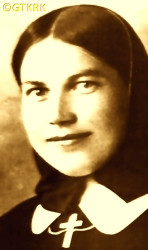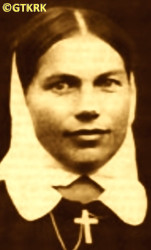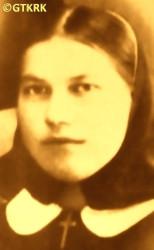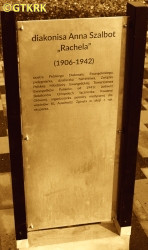Roman Catholic
St Sigismund parish
05-507 Słomczyn
85 Wiślana Str.
Konstancin deanery
Warsaw archdiocese, Poland
full list:
displayClick to display full list

searchClick to search full list by categories
wyświetlKliknij by wyświetlić pełną listę po polsku

szukajKliknij by przeszukać listę wg kategorii po polsku

Martyrology of the clergy — Poland
XX century (1914 – 1989)
personal data
surname
SZALBOT
surname
versions/aliases
SZALBÓT
forename(s)
Anne (pl. Anna)
religious forename(s)
Rachela
function
deaconess
creed
Evangelical Church of the Augsburg Confession in Poland EA
honorary titles
Order of the Cross of Grunwald — 3rd Classmore on
Order of the Cross of Grunwald – 3rd_Class
(22.03.1972)
Auschwitz Crossmore on
Auschwitz Cross
date and place
of death
30.12.1942

Osiektoday: Osiek gm., Oświęcim pov., Lesser Poland voiv., Poland
more on
en.wikipedia.org
[access: 2021.12.18]
alt. dates and places
of death
17.12.1943
KL Auschwitzconcentration camp
today: Oświęcim, Oświęcim gm., Oświęcim pov., Lesser Poland voiv., Poland
more on
en.wikipedia.org
[access: 2022.01.09]
details of death
After German and Russian invasion of Poland in 09.1939 and start of the World War II, after start of German occupation (her family region was directly incorporated into Germany as initially in Germ. Provinz Schlesien — Eng. Silesia Province; and from 1941 Germ. Provinz Oberschlesien — Eng. Upper Silesia Province) collaborated with Polish Clandestine Peasants' Battalions BCh, founded in 1940/41 (part of Polish Clandestine State).
Sworn in 06.1941 under nom‐de‐guerre „Rachela”.
In danger of imminent arrest — managed to escape from a house in Cieszyn surrounded by murderous German political police Gestapo — went into hiding: initially in Sosnowiec, and then, after illegally crossing over the border to German‐run Germ. Generalgouvernement (Eng. General Governorate), in Warsaw, where was known under name „Helene Wodecka”.
Became a courier and liaison officer of BCh High Command.
Was carrying and distributing medicine drugs and letter to and from Kraków and got involved with help being provided to the prionsers German concentration camp KL Auschwitz — having to cross illegally the border to Germ. Provinz Oberschlesien numerous times.
Brought medicines, food, money, food stamps, etc.
During her trips made injections for prisoners working out of the camps' compound.
Finally during the night of 29‐30.12.1942 apprehended by the Gestapo in Osiek n. KL Auschwitz (with her BCh co‐conspirator), when after arrival from Warsaw was preparing parcels for the prisoners.
Took a risk and attempted to flee.
Got shot and perished on the spot.
Her body Germans burnt in KL Auschwitz crematorium…
alt. details of death
According to some sources after arrest held — wounded — captive and on 12.10.1943, i.e. almost a year later, transported to KL Auschwitz concentration camp (in camp's archive there is a record of a person with her forename and surname, prisoner no 64947, but wrong date of birth).
There was to perish.
cause of death
murder
perpetrators
Germans
sites and events
KL AuschwitzClick to display the description, GeneralgouvernementClick to display the description, Regierungsbezirk KattowitzClick to display the description, Ribbentrop‐MolotovClick to display the description
date and place
of birth
18.06.1906

Malinkatoday: neighborhood in Wisła city, Wisła urban gm., Cieszyn pov., Silesia voiv., Poland
more on
en.wikipedia.org
[access: 2022.01.28]
religious vows
05.08.1927 (last)
positions held
1927 – c. 1940
deaconess — Dzięgielówtoday: Goleszów gm., Cieszyn pov., Silesia voiv., Poland
more on
en.wikipedia.org
[access: 2022.01.28] ⋄ Motherhouse, Eben–Ezer Deaconate of the Evangelical–Augsburg Church in Poland — also: member of the Polish Women's Circle, activist of the peasant movement, scout team leader
from 1938
nurse — Wisłatoday: Wisła urban gm., Cieszyn pov., Silesia voiv., Poland
more on
en.wikipedia.org
[access: 2022.01.28] — first aid nurse
c. 1928 – 1938
head/manager — Golasowicetoday: Pawłowice gm., Pszczyna pov., Silesia voiv., Poland
more on
en.wikipedia.org
[access: 2022.01.28] ⋄ „Mother and Child Station” center
from c. 1927
nurse — Cieszyntoday: Cieszyn gm., Cieszyn pov., Silesia voiv., Poland
more on
en.wikipedia.org
[access: 2021.12.18] ⋄ Silesian Hospital (national)
1927
accession — Dzięgielówtoday: Goleszów gm., Cieszyn pov., Silesia voiv., Poland
more on
en.wikipedia.org
[access: 2022.01.28] ⋄ Motherhouse, Eben–Ezer Deaconate of the Evangelical–Augsburg Church in Poland
sites and events
descriptions
KL Auschwitz: German Germ. Konzentrationslager (Eng. concentration camp) KL and Germ. Vernichtungslager (Eng. extermination camp) VL Auschwitz was set up by Germans around 27.01.1940 n. Oświęcim, on the German territory (initially in Germ. Provinz Schlesien — Silesia Province; and from 1941 Germ. Provinz Oberschlesien — Upper Silesia Province). Initially mainly Poles were interned. From 1942 it became the centre for holocaust of European Jews. Part of the KL Auschwitz concentration camps’ complex was Germ. Vernichtungslager (Eng. extermination camp) VL Auschwitz II Birkenau, located not far away from the main camp. There Germans murdered likely in excess of million people, mainly Jews, in gas chambers. In KL Auschwitz alone, the Germans murdered c. 30,000 prisoners by lethal injection. Until 1941, people were killed by intravenous injections of concentrated hydrogen peroxide, ether, hydrogen peroxide, or gasoline. Later, an intracardiac injection was used — with a needle about 10 cm long — of 10‐15 ml of a 30% solution of phenol C6H5OH (acquired from the German concern IG Farben, or more precisely from its subsidiary Bayer, and still used by Bayer AG, among others, for the production of aspirin), which killed within 15 seconds. Altogether In excess of 400 priests and religious went through the KL Auschwitz, c. 40% of which were murdered (mainly Poles). (more on: en.auschwitz.org.plClick to attempt to display webpage
[access: 2012.11.23], www.meczennicy.pelplin.plClick to attempt to display webpage
[access: 2013.07.06])
Generalgouvernement: After the Polish defeat in the 09.1939 campaign, which was the result of the Ribbentrop‐Molotov Pact and constituted the first stage of World War II, and the beginning of German occupation in part of Poland (in the other, eastern part of Poland, the Russian occupation began), the Germans divided the occupied Polish territory into five main regions. In two of them new German provinces were created, two other were incorporated into other provinces. However, the fifth part was treated separately, and in a political sense it was supposed to recreate the German idea from 1915 (during World War I, after the defeat of the Russians in the Battle of Gorlice in 05.1915) of creating a Polish enclave within Germany. Illegal in the sense of international law, i.e. Hague Convention, and public law, managed by the Germans according to separate laws — especially established for the Polish Germ. Untermenschen (Eng. subhumans) — till the Russian offensive in 1945 it constituted part of the Germ. Großdeutschland (Eng. Greater Germany). Till 31.07.1940 formally called Germ. Generalgouvernement für die besetzten polnischen Gebiete (Eng. General Government for the occupied Polish lands) — later simply Germ. Generalgouvernement (Eng. General Governorate), as in the years 1915‐1918. From 07.1941, i.e. after the German attack on 22.06.1941 against the erstwhile ally, the Russians, it also included the Galicia district, i.e. the Polish pre‐war south‐eastern voivodeships. A special criminal law was enacted and applied to Poles and Jews, allowing for the arbitrary administration of the death penalty regardless of the age of the „perpetrator”, and sanctioning the use of collective responsibility. After the end of the military conflict of the World War UU, the government of the Germ. Generalgouvernement was recognized as a criminal organization, and its leader, governor Hans Frank, guilty of war crimes and crimes against humanity and executed. (more on: en.wikipedia.orgClick to attempt to display webpage
[access: 2024.12.13])
Regierungsbezirk Kattowitz: After the Polish defeat in the 09.1939 campaign, which was the result of the Ribbentrop‐Molotov Pact and constituted the first stage of World War II, and the beginning of German occupation in part of Poland (in the other, eastern part of Poland, the Russian occupation began), the Germans divided the occupied Polish territory into five main regions (and a few smaller). The largest one was transformed into Germ. Generalgouvernement (Eng. General Governorate), intended exclusively for Poles and Jews and constituting part of the so‐called Germ. Großdeutschland (Eng. Greater Germany). From two separate new provinces were created. The two remaining were incorporated into existing German provinces. One of those was Polish Upper Silesia, which on 08.09.1939, by decree of the German leader Adolf Hitler (formally came into force on 26.10.1939), was incorporated into Germany as the Germ. Regierungsbezirk Kattowitz (Eng. Katowice Regency) and became part of the Germ. Provinz Schlesien (Eng. Province of Silesia) based in Wrocław. On 01.04.1940, the Germ. Regierungsbezirk Kattowitz was enlarged by several pre‐war German counties, and on 18.01.1941, a new German province was created, the Germ. Provinz Oberschlesien (Eng. Province of Upper Silesia), which, apart from the Germ. Regierungsbezirk Kattowitz, also included the Opole region. From 26.10.1939, when the regency was established, the law of the German state was in force there, the same as in Berlin. The main axis of the policy of the new regency, the territory of which the Germans recognized as the Germ. „Ursprünglich Deutsche” (Eng. „natively German”), despite the fact only 6% of its pre–war Polish part were Germans, was Germ. „Entpolonisierung” (Eng. „Depolonisation”), i.e. forced Germanization. The main mechanism was the introduction of the Germ. Deutsche Volksliste DVL, a German nationality list that was supposed to specify the national affiliation of the inhabitants of the region. The largest group marked in the compulsory registrations was Group 3, people who identified themselves as „Silesians” (in 1943 about 41%), and people remaining outside the DVL (about 36%). The latter group was intended to be deported to the Germ. Generalgouvernement (which did not happen en masse because German industry needed slave labor). Group 3, considered by the Germans as capable of Germanization, was subject to certain legal restrictions, and was subject to, among others, to conscription into the German Wehrmacht army. Children could only learn in German. A policy of terror was pursued against the Polish population. There was a special police court, controlled by the Germ. Geheime Staatspolizei (Eng. Secret State Police), i.e. the Gestapo, before which c. 4,000‐5,000 people were detained. For the years 1942‐1945 over 2,000 of them were verified, of which 1,890 were sentenced to death, including 286 in public executions. Thousands of people were murdered during the so‐called «Intelligenzaktion Schlesien», including 300‐650 Polish teachers and c. 61 Polish Catholic priests. The regency hosted a German concentration and extermination camp KL Auschwitz, where the Germans imprisoned c. 1,100,000 Jews (murdering c.1,000,000, i.e. c. 90% of them) and c. 140,000 Poles (murdering c. 70,000, i.e. c. 50% of them). After the end of hostilities of World War II, the overseer of this province, the Germ. Reichsstatthalter (Eng. Reich Governor) and the Germ. Gauleiter (Eng. district head) of the German National Socialist Party, Fritz Brecht, committed suicide. (more on: en.wikipedia.orgClick to attempt to display webpage
[access: 2024.06.24])
Ribbentrop‐Molotov: Genocidal Russian‐German alliance pact between Russian leader Joseph Stalin and German leader Adolf Hitler signed on 23.08.1939 in Moscow by respective foreign ministers, Mr. Vyacheslav Molotov for Russia and Joachim von Ribbentrop for Germany. The pact sanctioned and was the direct cause of joint Russian and German invasion of Poland and the outbreak of the World War II in 09.1939. In a political sense, the pact was an attempt to restore the status quo ante before 1914, with one exception, namely the „commercial” exchange of the so‐called „Kingdom of Poland”, which in 1914 was part of the Russian Empire, fore Eastern Galicia (today's western Ukraine), in 1914 belonging to the Austro‐Hungarian Empire. Galicia, including Lviv, was to be taken over by the Russians, the „Kingdom of Poland” — under the name of the General Governorate — Germany. The resultant „war was one of the greatest calamities and dramas of humanity in history, for two atheistic and anti‐Christian ideologies — national and international socialism — rejected God and His fifth Decalogue commandment: Thou shall not kill!” (Abp Stanislav Gądecki, 01.09.2019). The decisions taken — backed up by the betrayal of the formal allies of Poland, France and Germany, which on 12.09.1939, at a joint conference in Abbeville, decided not to provide aid to attacked Poland and not to take military action against Germany (a clear breach of treaty obligations with Poland) — were on 28.09.1939 slightly altered and made more precise when a treaty on „German‐Russian boundaries and friendship” was agreed by the same murderous signatories. One of its findings was establishment of spheres of influence in Central and Eastern Europe and in consequence IV partition of Poland. In one of its secret annexes agreed, that: „the Signatories will not tolerate on its respective territories any Polish propaganda that affects the territory of the other Side. On their respective territories they will suppress all such propaganda and inform each other of the measures taken to accomplish it”. The agreements resulted in a series of meeting between two genocidal organization representing both sides — German Gestapo and Russian NKVD when coordination of efforts to exterminate Polish intelligentsia and Polish leading classes (in Germany called «Intelligenzaktion», in Russia took the form of Katyń massacres) where discussed. Resulted in deaths of hundreds of thousands of Polish intelligentsia, including thousands of priests presented here, and tens of millions of ordinary people,. The results of this Russian‐German pact lasted till 1989 and are still in evidence even today. (more on: en.wikipedia.orgClick to attempt to display webpage
[access: 2015.09.30])
sources
personal:
www.bsip.miastorybnik.plClick to attempt to display webpage
[access: 2021.12.19], www.cieszyn.plClick to attempt to display webpage
[access: 2020.05.25], docplayer.plClick to attempt to display webpage
[access: 2020.05.25]
original images:
www.wszechnica.cieszyn.plClick to attempt to display webpage
[access: 2020.05.25], www.bsip.miastorybnik.plClick to attempt to display webpage
[access: 2021.12.19], kety.plClick to attempt to display webpage
[access: 2020.05.25], infobeskidy.euClick to attempt to display webpage
[access: 2020.05.25]
LETTER to CUSTODIAN/ADMINISTRATOR
If you have an Email client on your communicator/computer — such as Mozilla Thunderbird, Windows Mail or Microsoft Outlook, described at WikipediaPatrz:
en.wikipedia.org, among others — try the link below, please:
LETTER to CUSTODIAN/ADMINISTRATORClick and try to call your own Email client
If however you do not run such a client or the above link is not active please send an email to the Custodian/Administrator using your account — in your customary email/correspondence engine — at the following address:

giving the following as the subject:
MARTYROLOGY: SZALBOT Anne
To return to the biography press below:
 Click to return to biography
Click to return to biography











